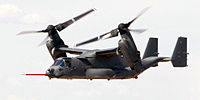Aggressive landing will set of a Vortex Ring State, which can become asymmetrical, causing an uncontrolled rolling motion of the aircraft from which recovery is nearly impossible. I believe the Navy restricts the craft's descent to no more than 800 feet/minute. At least one of the Osprey crashes was due to the pilots landing the aircraft too aggressively, causing the Vortex rotor and uncontrolled rolling. All aboard were lost.
Vortex ring effect in helicopters


The curved arrows indicate airflow circulation about the rotor disc. The helicopter shown is the
RAH-66 Comanche.


The
V-22 Osprey in flight.
Vortex ring state (VRS), also known as
settling with power, is a hazardous condition encountered in helicopter flight. It occurs when the helicopter has three things occurring: A high rate of descent , an airspeed slower than effective
translational lift, and the helicopter is using a large portion of its available power. A helicopter typically induces a vortex ring state by descending into its own downwash. In typical flight, the rotor disc directs the airflow downwards, creating
lift. During VRS, a
toroid-shaped path of airflow circumscribes the blade disc, as the airflow moves down through the disc, then outward, and then down through the top again. This re-circulation of flow can negate much of the lifting force and cause a catastrophic loss of altitude. Specific to vortex ring state is that the helicopter operating in its own downwash is descending through descending air. Applying more power (increasing collective pitch) serves to further accelerate the downwash through which the main-rotor is descending, exacerbating the condition. A particularly deadly example occurred on April 8, 2000, when a
V22 Osprey suffered VRS as a result of a classic high descent and low forward airspeed. The fully-laden aircraft stalled its right wing, rolled over, and crashed, killing all 19 aboard.
In single rotor helicopters, a VRS can be corrected by moving the
cyclic forward, which controls the pitch angle of the rotor blade, slightly pitching nose down, and establishing forward flight. In tandem-rotor helicopters, recovery is accomplished through lateral cyclic or pedal input. The aircraft will fly into "clean air", and will be able to regain lift.






